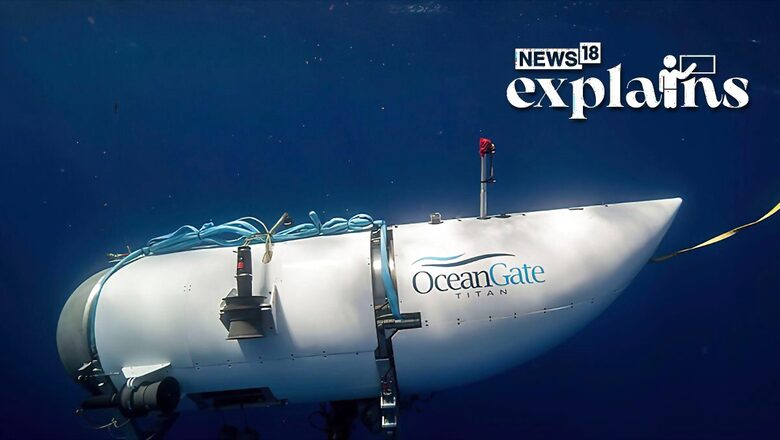
views
A small underwater vehicle with five people onboard that went to visit the remains of the Titanic in the deep sea has not been found yet, even after a big search effort.
However, there have been reports of banging sounds in the area. Canadian aircraft detected underwater noises, but the source of the sounds couldn’t be determined by the US Coast Guard, a CNN report said.
A government memo mentioned that search teams heard banging sounds at regular intervals, and there is still hope for survivors based on the feedback from underwater sound signals, as per the report.
How Did it Go Missing, Who Was on Board?
The Titan submersible, which was heading towards the famous wreckage of the Titanic off the coast of Newfoundland, Canada, lost contact with its support ship. The people on board the submersible only have enough oxygen for a few days, according to CNN.
The submersible was part of an eight-day journey organized by OceanGate Expeditions, with a price of $250,000 per person.
The trip started in Newfoundland and involved a 400 nautical mile journey to the wreck site, located about 900 miles (1,450 kilometers) off the coast of Cape Cod, Massachusetts.
During the descent to the wreck, the submersible lost contact with the support ship. Search operations were initiated on the same day.
The names of the five missing individuals have not been officially disclosed, but it has been confirmed that British businessman Hamish Harding, French diver Paul-Henri Nargeolet, Pakistani billionaire Shahzada Dawood, and his son Sulaiman Dawood were among them, according to CNN. The fifth person is believed to be Stockton Rush, the CEO and founder of OceanGate.
Have There Been Safety Concerns About Oceangate Before?
The recent incident involving the missing Titan submersible has sparked discussions about the safety of deep-sea tourism, particularly focusing on OceanGate, the company involved, according to CNN.
Former employees of OceanGate have raised concerns about the thickness of the Titan’s hull, suggesting potential safety issues.
Furthermore, conflicting information has emerged regarding the engineering and testing of the vessel, with a research lab’s statement indicating discrepancies.
Despite OceanGate’s legal representative claiming the Titan’s exceptional safety features, the University of Washington’s Applied Physics Laboratory, allegedly involved in its development, denied any association with the design, engineering, or testing of the submersible.
Industry leaders also expressed concerns about OceanGate’s “experimental approach” to the Titan submersible and its Titanic expedition, as highlighted in a letter sent to the missing CEO, Stockton Rush, by the Manned Underwater Vehicles committee of the Marine Technology Society in 2018. The letter warned of potential negative outcomes with serious consequences for the industry.
Passengers who were about to board OceanGate’s submarines for the expedition to the Titanic wreckage were presented with a contract warning them about the potential risks involved. The contract stated that the expedition had not been approved or certified by any regulatory body and that it carried the possibility of physical injury, disability, motion trauma, or even death, according to a report by The Independent.
A Deeper Look at the Issues
There have been several warning signs about potential issues with OceanGate’s Titan submarine. A former employee, David Lochridge, filed a lawsuit alleging that he was fired for raising concerns about safety issues with the ship.
These concerns included flaws in the hull, flammable materials onboard, an inadequate viewing window, and missing safety documents. Lochridge pushed for further testing and third-party evaluation but was terminated when he refused to authorize manned testing without hull scans.
In addition, an industry letter in 2018 expressed unanimous concern about the company’s decision not to seek external evaluation and testing, emphasizing the importance of safeguards in submersibles.
How the Company Had Defended Itself?
In a blog post in 2019, OceanGate defended its decision not to have its submarine “classed” by an external evaluator, stating that the majority of marine accidents are caused by operator error rather than mechanical failure, the report by The Independent said.
They argued that focusing solely on vessel classification does not address operational risks and emphasized the importance of maintaining high-level operational safety through constant effort and a strong corporate culture.
In the same year, CEO Stockton Rush expressed concerns that submarine regulations were hindering innovation in an interview with Smithsonian Magazine. In 2020, he mentioned that the submarine’s hull was experiencing “cyclic fatigue,” a technical issue that former employee David Lochridge had reportedly raised concerns about.
The company conducted tests, including a 4,000-meter deep dive in the Bahamas, and temporarily downgraded the hull depth rating of the Titanic submarine to 3,000 meters, which is 1,000 meters less than the depth of the Titanic, the report said.















Comments
0 comment